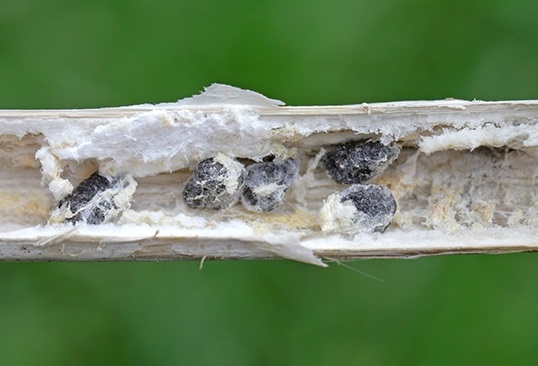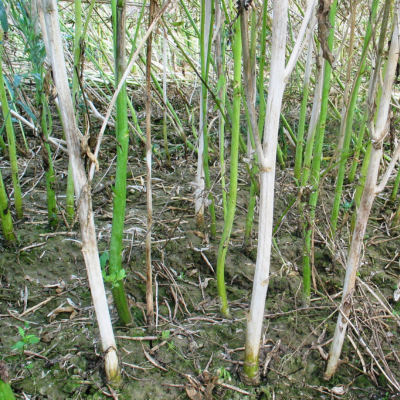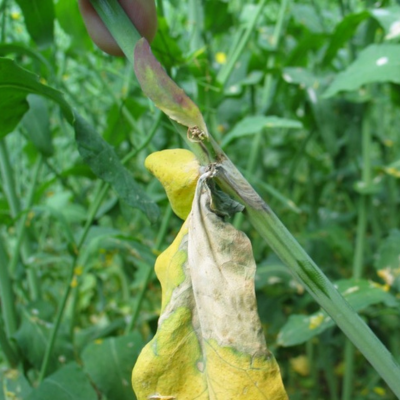Sclerotinia stem rot is a soil-borne pathogen that can impact a range of UK crops, including oilseed rape, potatoes, beans, carrots and spring field beans.
Sclerotinia Stem Rot

What is Sclerotinia sclerotiorum?
Sclerotinia stem rot or Sclerotinia sclerotiorum is a soil-borne pathogen that presents itself as a white mould on plants. It’s a common disease that can impact a range of UK crops, including:
One of the most challenging aspects of pinpointing and managing sclerotinia risk is diagnosing the disease before it impacts the crop, since most fungicides are protective rather than curative.
The severity of the infection can be sporadic, but years with high rainfall or humidity create the ideal conditions for the infection to spread, causing significant yield loss.
This yield loss varies from year to year and depends largely on the fields affected, but a general rule of thumb is around half the infection level, such as 50% infection equalling around 25% yield loss, for example.
What causes sclerotinia stem rot in oilseed rape?
Sclerotinia sclerotiorum infection occurs as oilseed rape begins to flower and is affected by airborne spores, which is highly dependent on moisture conditions before and during the flowering process.

Prolonged soil moisture, high humidity and air temperatures of between 20-25°C are ideal conditions for this disease to develop quickly, since the spores can live within the soil as seed-like mycelial masses, known as sclerotia, for up to eight years.
Fruiting bodies, known as apothecia, germinate from the sclerotia and produce millions of spores that travel on the wind and land on the petals of flowering crops, such as oilseed rape, and use the petals as a source of nutrients to continue to spread.
The infection can spread quickly due to its preference for dense canopies with little airflow and high moisture.
How to spot sclerotinia?

Sclerotia infected stem

Sclerotia infected leaf
The infection starts as a watery, soft rot on the infected stems and leaves. Lesions will then appear, which can girdle the main stem, eventually resulting in plant wilting, lodging and the eventual death of the plant.
The infected areas of the plant will dry up and bleach, and petal drop typically begins 6-9 days after flowering, coinciding with the 30% bloom stage of the plant.
Once the infected petals and leaves fall off the plant, the sclerotinia can spread by infecting both the stem and the branches.
The disease can also spread during harvest, when plant matter is shredded, releasing the disease from the infected stems, contributing inoculum to the soil for successive growing seasons.
Why is Sclerotinia sclerotiorum a problem?
Although sclerotinia risk will not be present every year in the UK, once it takes hold of a crop, particularly oilseed rape, yields can be absolutely devastated.
In some advanced cases of the infection, yield loss can be up to 60%.
Sclerotinia stem rot is typically the main infection to consider once oilseed rape begins to flower, alongside other crops such as potatoes, beans, carrots, spring field beans.
Although the lifecycle of the pathogen is complex, familiarising yourself with the three predominant risk factors will help you develop a targeted approach to disease management and prevention:
Presence of spores
Warm and humid conditions
Crops in flower
How do I control sclerotinia?
Determining fungicide control can be a tough task due to the sporadic nature of the disease. However, the first step to controlling or preventing sclerotinia stem rot is understanding the following:
Historical infection levels in your fields and any neighbouring oilseed rape fields.
Rainfall and humidity factors 10-14 days before and during flowering.
Plant density.
Crop rotation.
Future weather forecasts, with a focus on humidity and precipitation.

Genetic resistance
PT303 Protector® Sclerotinia and PT312 are the first winter oilseed rape hybrids to offer growers in the UK and Ireland top level yields with built-in tolerance to Sclerotinia.
PT312 provides a very high gross output yield with a very high oil content combined with turnip yellows virus resistance and Sclerotinia tolerance.
PT322 combines Sclerotinia tolerance with high oil content (47.9%) and strong resistance to Light Leaf Spot (8) and Stem Canker (7).
Utilising genetic resistance offers season-long protection from sclerotinia and ensures that the protection is planted with the seed.
Latest news
The ever-present threat of sclerotinia
Corteva’s trials show that when sclerotinia infection levels are 25% or above the severity of the disease in PT303 is reduced by up to 75%.